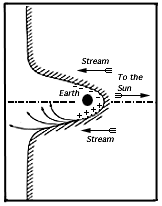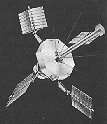|
They realized that the strong field of the Earth would hold off the cloud, carving a cavity in the cloud in which the Earth and its magnetic field would be confined (see drawing above, from their 1931 article). They also speculated that a ring current would then be set up, though they had no clear idea of the way it happened.
The theory of the "Chapman-Ferraro Cavity" proved to be prophetic, except for one important detail: the flow of plasma from the Sun was not confined to isolated clouds, but went on all the time, in the form of the solar wind. Denser and faster clouds, such as arise from coronal mass ejections (see corona), were later identified as the real cause of sudden commencements.
|

 Explorer 12.
Explorer 12. Official GSFC Home Page
Official GSFC Home Page  NASA WWW Home Page
NASA WWW Home Page